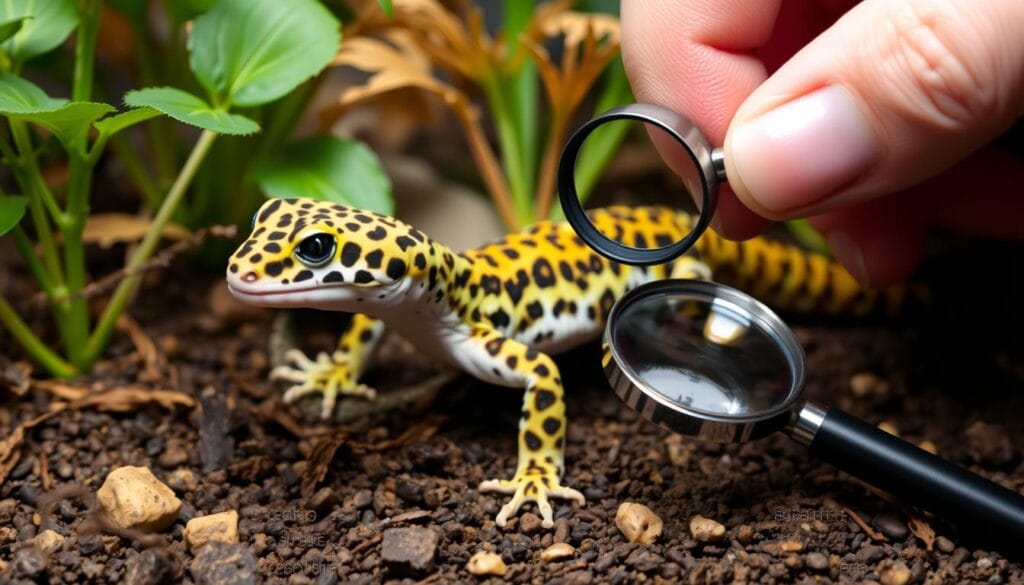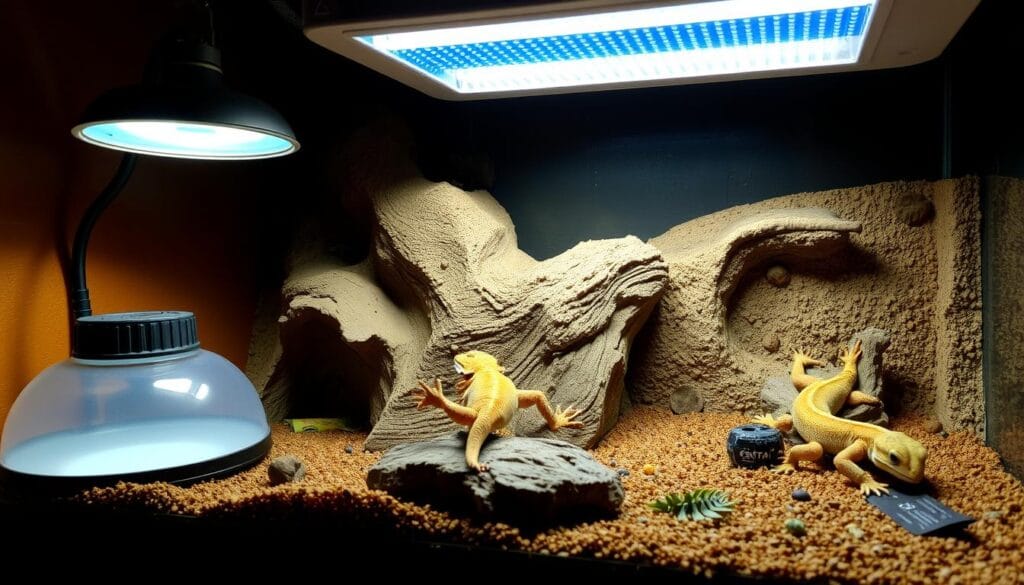When I first brought home my leopard gecko, I felt like a nervous parent. Every rustle, every subtle movement made me worry. I soon learned that caring for a leopard gecko isn’t about being perfect. It’s about understanding their unique needs.
Leopard gecko care needs precision and knowledge. Setting up their habitat and feeding them right are key to their health and long life. Experienced owners know that small mistakes can cause big health problems for these delicate creatures.
If you’re new to gecko ownership or want to improve your care, knowing common mistakes is key. This guide will help you avoid habitat and diet mistakes. It will show you how to create the best environment for your gecko.
Table of Contents
Understanding Leopard Gecko Needs
Creating the perfect leopard gecko habitat needs careful planning. These fascinating reptiles have specific needs for their health and happiness.
Basic Habitat Requirements
When setting up a leopard gecko tank, size is key. A 20-gallon long enclosure is the minimum space needed. Experts suggest upgrading to a 40-gallon for better comfort. Your gecko’s home should include:
- Secure vivarium with proper ventilation
- Minimum dimensions of 3 feet wide
- Substrate mix of 70% organic topsoil and 30% play sand
Temperature and Lighting Needs
Leopard gecko lighting is vital for their health. The enclosure must have a precise temperature gradient:
| Area | Temperature |
|---|---|
| Warm Hide | 90°F |
| Cool Side | 70-77°F |
Use a Zoo Med ReptiSun T5 HO 5.0 UVB bulb for 12 hours daily. This supports vitamin D3 synthesis.
Importance of Humidity
Maintaining the right humidity is key in your leopard gecko habitat. These reptiles prefer low-humidity environments. But, a humid hide is essential during shedding periods.
- Overall enclosure humidity: 30-40%
- Humid hide humidity: 70-80%
“A well-designed habitat is the foundation of a healthy, happy leopard gecko.” – Reptile Care Experts
Common Mistakes in Habitat Setup
Setting up the perfect leopard gecko habitat needs careful planning. Many owners make mistakes that can harm their pet’s health and happiness.
When setting up a leopard gecko tank, space and enrichment are key. A small or poorly designed habitat can stress your gecko a lot.
Inadequate Space and Enrichment
Your leopard gecko needs room to explore and feel at home. Experts say a 20-gallon tank is a good size for one gecko. For more geckos, add more space. Make the environment fun with:
- Multiple hiding spots
- Low climbing branches
- Varied terrain
- Safe climbing structures
Poor Substrate Choices
Choosing the right substrate is very important. Bad choices like loose sand or sharp materials can hurt your gecko’s health.
- Best substrates for adult geckos:
- Soil/sand mix
- Reptile carpet
- Slate tiles
- Avoid:
- Calcium sand
- Fine grain sand
- Unsafe loose materials
Ignoring Hiding Spots
Leopard geckos are shy and need safe places. Multiple hiding spots are essential for their well-being.
“A well-designed habitat mimics a gecko’s natural environment, promoting mental and physical well-being.”
Make sure your leopard gecko tank has at least three hiding spots. Include a humid hide with damp moss to help with shedding.
Feeding Errors to Avoid
Feeding your leopard gecko right is key to their health and long life. Knowing how to feed them well can stop common diet mistakes. These mistakes could harm your gecko’s health.
Choosing the Right Diet
Leopard geckos only eat live insects. They hunt like they do in the wild. Here are some important diet tips:
- Give them a variety of live insects
- Feed insects that are full of nutrients
- Put calcium powder on the insects
- Don’t use insects caught in the wild
Preventing Overfeeding Risks
Too much food can hurt your gecko. It’s important to feed the right amount.
| Age Group | Feeding Frequency | Portion Size |
|---|---|---|
| Juvenile Geckos | Daily | 5-7 insects per meal |
| Adult Geckos | Every other day | 3-5 insects per meal |
Feeding Schedule and Techniques
When and how often you feed is very important. Follow these tips for the best nutrition:
- Feed in the evening
- Take away uneaten food in 15-20 minutes
- Change the water every day
- Use shallow dishes for water
“A well-planned diet is the foundation of your leopard gecko’s health and happiness.”
Learning these feeding tips can help your leopard gecko stay healthy. It also helps avoid diet mistakes.
Disregarding Health Checks
Keeping your leopard gecko healthy means watching them closely and taking them to the vet often. If you ignore their health, you might miss chances to stop big problems.

Knowing how to spot health issues is part of caring for your gecko. Catching problems early can greatly improve your pet’s health.
Signs of Illness in Leopard Geckos
Look out for these important health signs:
- Significant weight loss
- Unusual lethargy
- Abnormal droppings
- Respiratory difficulties
- Changes in eating habits
Regular Vet Visits
It’s important to take your gecko to the vet regularly. A reptile expert can:
- Do full physical checks
- Check for parasites
- Look at their diet
- Give advice on staying healthy
Quarantine New Geckos Properly
When you bring a new gecko home, keep it separate for at least 30 days. This helps stop diseases from spreading.
“Prevention is always better than cure in reptile care.” – Reptile Veterinary Association
| Health Indicator | Normal Status | Potential Concern |
|---|---|---|
| Weight | Consistent | Sudden loss/gain |
| Appetite | Regular eating | Reduced intake |
| Skin/Shedding | Clean, complete shed | Incomplete/problematic shedding |
Spotting problems early and getting vet advice is key to keeping your leopard gecko healthy and happy.
Neglecting Temperament and Behavior
It’s important to know how to handle your leopard gecko. These pets have their own way of talking to us. We need to pay attention and show respect.
Understanding Leopard Gecko Communication
Leopard geckos show us how they feel through their body language. They talk to us in their own special way:
- Tail wagging means they might be upset
- Tail rattling shows they’re excited or defending their space
- Slow movements mean they’re feeling calm
Effective Leopard Gecko Handling Techniques
Handling a leopard gecko needs patience and care. Here are some tips for gentle interaction:
- Let them get used to their new home first
- Hold them gently, supporting their whole body
- Don’t move too fast or grab them suddenly
- Start with short, calm handling sessions
“Respect and understanding are key to building trust with your leopard gecko.”
Socialization Strategies
Slowly getting your gecko used to you helps them feel less stressed. Start with short, calm times together. Remember, every gecko is different, so be patient.
By learning about their behavior and handling them gently, you can have a great time with your gecko.
Misunderstanding Shedding Needs
Many pet owners don’t understand the importance of leopard gecko shedding. Knowing how shedding works is key to keeping your gecko healthy. It also helps avoid any problems.
The Importance of Proper Shedding Conditions
Creating the right environment is vital for a smooth shed. Your leopard gecko needs certain humidity levels and places to hide. The best humidity for them is between 30% and 40%.
- Maintain consistent humidity levels
- Provide a dedicated humid hide
- Use damp moss in the shedding area
- Monitor your gecko during shedding periods
How to Help Your Gecko Shed
If your leopard gecko has trouble shedding, you can help. Here are some ways to assist your gecko:
- Create a humid hide with damp moss
- Never pull stuck shed manually
- Soak your gecko in lukewarm water for 10-15 minutes
- Use a soft, damp cloth to help remove loose skin
*Pro Tip*: A successful shed indicates good health and proper leopard gecko care.
Shedding Frequency Insights
| Gecko Age | Shedding Frequency | Notes |
|---|---|---|
| Juvenile | Every 1-2 weeks | Rapid growth phase |
| Adult | Every 4-8 weeks | Slower growth rate |
Ignoring Water and Hydration Needs
Proper leopard gecko care means paying close attention to hydration. Water is key to keeping your gecko healthy. Many owners forget how important it is to manage water well.
Water Bowl Maintenance
Choose a shallow water dish for your gecko’s home to avoid drowning. Clean and change the water every day to stop bacteria. Your gecko’s water bowl should be:
- Shallow and stable
- Made of non-porous material
- Positioned in the cool area of the enclosure
- Cleaned with reptile-safe disinfectant
“Consistent water quality is as critical as temperature control for leopard gecko hydration.”
Providing Humidity through Misting
Leopard gecko hydration isn’t just about drinking water. Light misting helps with humidity, which is important during shedding. Create a dedicated humid hide to keep moisture levels right without making the whole enclosure damp.
Here’s how to mist right:
- Mist lightly to avoid too much moisture
- Focus on the humid hide area
- Use clean, chlorine-free water
- Check humidity with a hygrometer
Watch your gecko to see if it needs more water. Signs of dehydration include wrinkled skin, sunken eyes, and less activity. Always put your gecko’s water and humidity needs first for its health.
Inadequate Lighting and Heating
Creating the right leopard gecko habitat is all about lighting and temperature. Your gecko’s health depends on mimicking their natural desert environment. This means proper illumination and heat management.

Leopard gecko lighting is key to their well-being. They need specific light conditions for their metabolic processes and day-night cycles.
Essential Lighting Types for Leopard Geckos
- UVB lighting (2-5% strength)
- Heat emitters
- Ceramic heat lamps
- Natural daylight simulation
Creating the Perfect Heat Gradient
Designing a proper leopard gecko habitat means setting up a precise temperature gradient. Your enclosure should have different temperature zones. This lets your gecko regulate its body temperature naturally.
| Area | Temperature Range | Purpose |
|---|---|---|
| Basking Spot | 88°F (31°C) | Warmth and digestion |
| Cool End | 75°F (24°C) | Temperature regulation |
| Night Temperature | 70-75°F (21-24°C) | Natural cooling |
“Proper lighting is not a luxury, but a necessity for your leopard gecko’s survival and thriving.” – Reptile Care Experts
Use digital thermometers to monitor temperatures and invest in quality thermostats. Replace UV bulbs every 6-12 months to ensure consistent UV output. Remember, inadequate lighting can lead to serious health issues like metabolic bone disease.
Lighting Best Practices
- Provide 10-12 hours of UVB exposure daily
- Use UVB lights within 290-320 nm range
- Position UV sources to cover part of the basking area
- Use timers for consistent day-night cycles
Maintaining a Consistent Care Routine
Creating a structured care routine is key for leopard gecko care. Sticking to a schedule keeps your gecko healthy and happy for up to 20 years. Keeping detailed records is important, whether you’re breeding or tracking health.
Having a daily and weekly routine helps avoid health problems. Start with a spot-cleaning schedule for waste and habitat checks. Clean the habitat deeply once a month to prevent disease and keep your gecko’s home perfect.
Keeping records is essential in leopard gecko care. Note down feeding, shedding, weight changes, and behavior. These records help you understand your gecko’s health and can aid in quick vet diagnoses. For breeders, detailed profiles of each gecko are even more important.
As your leopard gecko gets older, around 18 years, your care routine needs to change. Regular checks, consistent habitat care, and keeping good records will help your gecko stay healthy for its whole life.

